


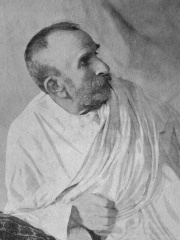
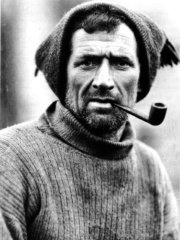
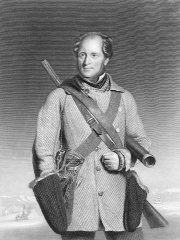
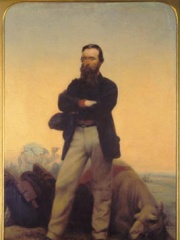
The Most Famous
EXPLORERS from Ireland
This page contains a list of the greatest Irish Explorers. The pantheon dataset contains 498 Explorers, 8 of which were born in Ireland. This makes Ireland the birth place of the 11th most number of Explorers behind Italy, and Netherlands.
Top 8
The following people are considered by Pantheon to be the most legendary Irish Explorers of all time. This list of famous Irish Explorers is sorted by HPI (Historical Popularity Index), a metric that aggregates information on a biography's online popularity.

1. Ernest Shackleton (1874 - 1922)
With an HPI of 72.88, Ernest Shackleton is the most famous Irish Explorer. His biography has been translated into 63 different languages on wikipedia.
Sir Ernest Henry Shackleton (15 February 1874 – 5 January 1922) was an Anglo-Irish Antarctic explorer who led three British expeditions to the Antarctic. He was one of the principal figures of the period known as the Heroic Age of Antarctic Exploration. Born in Kilkea, County Kildare, Ireland, Shackleton and his Anglo-Irish family moved to Sydenham in suburban south London when he was ten. Shackleton's first experience of the polar regions was as third officer on Captain Robert Falcon Scott's Discovery Expedition of 1901–1904, from which he was sent home early on health grounds, after he and his companions Scott and Edward Adrian Wilson set a new southern record by marching to latitude 82° S. During the Nimrod Expedition of 1907–1909, he and three companions established a new record Farthest South latitude of 88°23′ S, only 97 geographical miles (112 statute miles or 180 kilometres) from the South Pole, the largest advance to the pole in exploration history. Also, members of his team climbed Mount Erebus, the most active Antarctic volcano. On returning home, Shackleton was knighted for his achievements by King Edward VII. After the race to the South Pole ended in December 1911, with Roald Amundsen's conquest, Shackleton turned his attention to the crossing of Antarctica from sea to sea, via the pole. To this end, he made preparations for what became the Imperial Trans-Antarctic Expedition of 1914–1917. The expedition was struck by disaster when its ship, Endurance, became trapped in pack ice and finally sank in the Weddell Sea off Antarctica on 21 November 1915. The crew escaped by camping on the sea ice until it disintegrated, then by launching the lifeboats to reach Elephant Island and ultimately the South Atlantic island of South Georgia, enduring a stormy ocean voyage of 720 nautical miles (1,330 km; 830 mi) in Shackleton's most famous exploit. He returned to the Antarctic with the Shackleton–Rowett Expedition in 1921 but died of a heart attack while his ship was moored in South Georgia. At his wife's request, he remained on the island and was buried in Grytviken cemetery. The wreck of Endurance was discovered just over a century after Shackleton's death. Away from his expeditions, Shackleton's life was generally restless and unfulfilled. In his search for rapid pathways to wealth and security, he launched business ventures which failed to prosper, and he died heavily in debt. Upon his death, he was lauded in the press but was thereafter largely forgotten, while the heroic reputation of his rival Scott was sustained for many decades. Later in the 20th century, Shackleton was "rediscovered", and he became a role model for leadership in extreme circumstances. In his 1956 address to the British Science Association, one of Shackleton's contemporaries, Sir Raymond Priestley, said: "Scott for scientific method, Amundsen for speed and efficiency[,] but[,] when disaster strikes and all hope is gone, get down on your knees and pray for Shackleton", paraphrasing what Apsley Cherry-Garrard had written in a preface to his 1922 memoir The Worst Journey in the World. In 2002, Shackleton was voted eleventh in a BBC poll of the 100 Greatest Britons.

2. Antoine Thomson d'Abbadie (1810 - 1897)
With an HPI of 64.09, Antoine Thomson d'Abbadie is the 2nd most famous Irish Explorer. His biography has been translated into 28 different languages.
Antoine Thomson d'Abbadie d'Arrast (3 January 1810 – 19 March 1897) was a French-Basque explorer, geographer, ethnologist, linguist and astronomer of Irish birth, renowned for his expeditions in Ethiopia during the early 19th century. He was the elder brother of Arnaud-Michel d'Abbadie, who accompanied him on his travels.

3. Edward Bransfield (1785 - 1852)
With an HPI of 60.83, Edward Bransfield is the 3rd most famous Irish Explorer. His biography has been translated into 23 different languages.
Edward Bransfield (c. 1785 – 31 October 1852) was a Royal Navy officer who served as a master on several ships, after being impressed into service in Ireland at the age of 18. He is noted for his participation in several explorations of parts of Antarctica, including a sighting of the Trinity Peninsula in January 1820.

4. Arnaud-Michel d'Abbadie (1815 - 1893)
With an HPI of 57.50, Arnaud-Michel d'Abbadie is the 4th most famous Irish Explorer. His biography has been translated into 17 different languages.
Arnaud-Michel d'Abbadie d'Arrast (24 July 1815 – 8 November 1893), also listed as Michel Arnaud d'Abbadie in the Chambers Biographical Dictionary was a French-Basque explorer of Irish origin, renowned for his extensive travels in Ethiopia alongside his elder brother, Antoine d'Abbadie d'Arrast. Arnaud distinguished himself as a geographer, ethnologist, and linguist, gaining intimate knowledge of Abyssinian polemarchs and serving as an active observer of their battles and courtly life. In 1868, Arnaud published the seminal account of their travels, titled Douze ans de séjour dans la Haute-Ethiopie (Twelve Years in Upper Ethiopia in English), providing a comprehensive narrative of their twelve-year sojourn in the region.
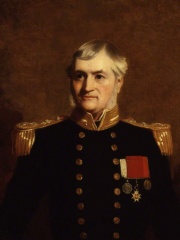
5. Henry Kellett (1806 - 1875)
With an HPI of 55.45, Henry Kellett is the 5th most famous Irish Explorer. His biography has been translated into 16 different languages.
Vice-Admiral Sir Henry Kellett, (2 November 1806 – 1 March 1875) was an Irish naval officer and explorer.

6. Tom Crean (1877 - 1938)
With an HPI of 52.93, Tom Crean is the 6th most famous Irish Explorer. His biography has been translated into 22 different languages.
Thomas Crean (Irish: Tomás Ó Cuirín; c. 16 February 1877 – 27 July 1938) was an Irish seaman and Antarctic explorer who was awarded the Albert Medal for Lifesaving (AM). Crean was a member of three major expeditions to Antarctica during the Heroic Age of Antarctic Exploration, including Robert Falcon Scott's 1911–1913 Terra Nova Expedition. This saw the race to reach the South Pole lost to Roald Amundsen and ended in the deaths of Scott and his party. During the expedition, Crean's 35-statute-mile (56 km) solo walk across the Ross Ice Shelf to save the life of Edward Evans led to him receiving the Albert Medal. Crean left the family farm near Annascaul, in County Kerry, to enlist in the Royal Navy at age 16. In 1901, while serving on Ringarooma in New Zealand, he volunteered to join Scott's 1901–1904 Discovery Expedition to Antarctica, thus beginning his exploring career. After his experience on the Terra Nova, Crean's third and final Antarctic venture was as second officer on Ernest Shackleton's Imperial Trans-Antarctic Expedition. After the ship Endurance became beset in the pack ice and sank, Crean and the ship's company spent 492 days drifting on the ice before undertaking a journey in the ship's lifeboats to Elephant Island. He was a member of the crew which made a small-boat journey of 800 nautical miles (1,500 km) from Elephant Island to South Georgia Island to seek aid for the stranded party. After retiring from the navy on health grounds in 1920, Crean ran his pub the South Pole Inn in County Kerry with his wife and daughters. He died in 1938.

7. Robert McClure (1807 - 1873)
With an HPI of 52.55, Robert McClure is the 7th most famous Irish Explorer. His biography has been translated into 19 different languages.
Vice-Admiral Sir Robert John Le Mesurier McClure (28 January 1807 – 17 October 1873) was an Irish explorer who explored the Arctic. In 1854 he traversed the Northwest Passage by boat and sledge, and was the first to circumnavigate the Americas.

8. Robert O'Hara Burke (1821 - 1861)
With an HPI of 52.44, Robert O'Hara Burke is the 8th most famous Irish Explorer. His biography has been translated into 18 different languages.
Robert O'Hara Burke (6 May 1821 – c. 28 June 1861) was an Irish soldier and police officer who achieved fame as an Australian explorer. He was the leader of the ill-fated Burke and Wills expedition, which was the first expedition to cross Australia from south to north, finding a route across the continent from the settled areas of Victoria to the Gulf of Carpentaria. The expedition party was well equipped, but Burke was not experienced in bushcraft. A Commission of Inquiry held by the Government of Victoria to investigate the failure of the expedition was a censure of Burke's judgement.
People
Pantheon has 8 people classified as Irish explorers born between 1785 and 1877. Of these 8, none of them are still alive today. The most famous deceased Irish explorers include Ernest Shackleton, Antoine Thomson d'Abbadie, and Edward Bransfield.
Deceased Irish Explorers
Go to all RankingsErnest Shackleton
1874 - 1922
HPI: 72.88
Antoine Thomson d'Abbadie
1810 - 1897
HPI: 64.09
Edward Bransfield
1785 - 1852
HPI: 60.83
Arnaud-Michel d'Abbadie
1815 - 1893
HPI: 57.50
Henry Kellett
1806 - 1875
HPI: 55.45
Tom Crean
1877 - 1938
HPI: 52.93
Robert McClure
1807 - 1873
HPI: 52.55
Robert O'Hara Burke
1821 - 1861
HPI: 52.44
Overlapping Lives
Which Explorers were alive at the same time? This visualization shows the lifespans of the 7 most globally memorable Explorers since 1700.

